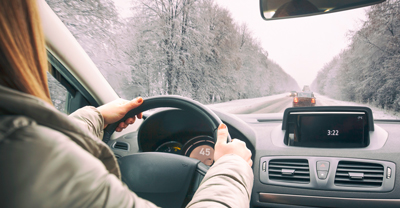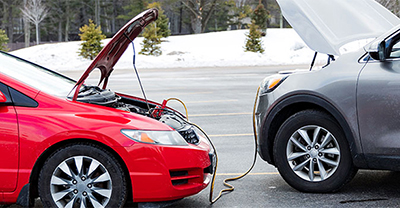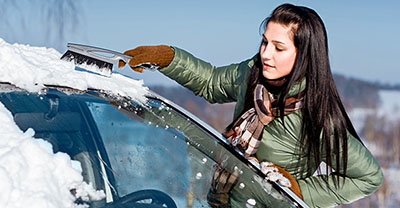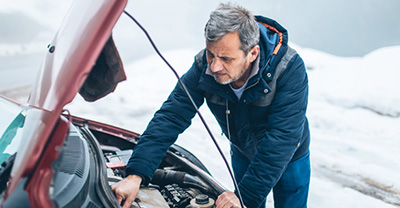Driving in cold weather: Myths and safety tips


0 min. read
“Is there a temperature that's too cold to safely operate my vehicle?”
“When is the right time to swap out my everyday tires and put the snow tires on?”
“Do I even need snow tires?”
Of the many cold-weather tips you've likely heard, which ones are actually true? Here, we'll bust some winter driving misconceptions and share tips for driving in cold weather this winter.
Winter weather driving quiz
How many of the following questions do you know the answers to?
A. Have a tread depth of at least 4/32-inch
B. Provide traction
C. Maintain a consistent pressure
D. All of the above
A. The end of your driveway
B. Your state line if you’re unsure of a neighboring state’s laws
C. The date your state's studded tire season ends
D. Both B & C
Cold weather driving misconceptions
Misconceptions about driving in cold and snowy weather are plentiful this time of year. Let’s take a look at some of the most common claims, and dispel some stubborn myths:
Myth: You don’t need snow tires if you have an all-wheel-drive (AWD) vehicle.
While having an AWD vehicle is beneficial in winter weather, it doesn’t solve all of the problems addressed by snow tires. Snow tire treads are specially designed to divert snow from the tire’s surface, allowing more contact between the rubber and the road—and as a result, better traction.
The rubber used to make snow tires is also more suited to cold temperatures, allowing for better grip than summer or all-season tires. You can use this attribute to help determine when you should make the switch into and out of snow tires each season. You don’t have to wait for snow! Just make sure the temps have dropped for the winter and you won’t be seeing any more 70-degree days. And if you’re opting for studs, make sure to adhere to state-specific guidelines.
Myth: You only need to install snow tires or studded tires on the drive wheels to aid traction.
Mixing tires on your vehicle isn’t recommended in any season because it can cause uneven wearing of your treads. You can put studded snow tires on just the drive tires—but only if your car is rear-wheel drive, and even then, it's not typically recommended.
But 4x4 and AWD vehicles must have studs on all four tires—not just two. This is especially crucial if a vehicle is front-wheel-drive (FWD). If a FWD car doing just 45 mph suddenly slams on the brakes with studs on the drive axle, the front of the car comes to a halt as the metal studs dig into the ice and snow. The rear end, however, doesn't stop. It could fishtail and send the car spinning out of control.
Your best bet is to change all four tires in the winter season. Pay attention to local laws and ordinances concerning studs and allow specialty tires to work in the ways and situations they were designed for.
Myth: Lower tire pressure provides better traction in winter weather.
Cold weather causes tires to lose PSI, but that doesn’t mean you should continue to drive on under-inflated tires. The myth is that slightly deflating the tires puts more surface area of the tires on the road. In reality, your tires will perform best when inflated to the manufacturer-recommended amount.
The cold temperatures cause the air in your tires to compress (which lowers the tire pressure), but they will gradually gain PSI as you drive and the tires heat up. If your low-pressure sensor remains on even after driving a couple of miles, find your nearest air compressor at a mechanic or service station and fill the tires up to the standard levels.
Myth: Snow blindness is worst during nighttime driving.
What you’re probably thinking of as “snow blindness” at nighttime is when blowing snow is lit up by your headlights (especially high beams) and it looks a little like the warp-speed effects in Star Wars. You should be wary of low visibility in that situation, but it’s not snow blindness.
Snow blindness is a daytime phenomenon when your eyes incur damage from the UV light reflected off snowy surfaces. It can feel like looking into the sun or being out on the water on a sunny day. Snow blindness can cause watery eyes, headaches, and reduced line of sight from squinting. Keep a pair of sunglasses in the car to help protect your eyes from UV rays.
Myth: You have to let your vehicle idle in the winter before driving to thin the oil.
This is one of those winter driving myths that used to be true but is no longer relevant. Modern fuel-injection systems only need 10 to 30 seconds to prime the engine for driving, even in very cold weather.
It’s true that cold, more viscus oil does make your engine work harder, but the best way to warm it up is by driving. If it’s really cold, you can take the first couple of miles slowly to gradually warm the oil and engine before climbing to highways speeds.
Today, the only reason to idle your car in the winter is to make it more comfortable when you leave, and to defrost your windows. Use of steering wheel and seat warmers can reduce the time needed to make your interior tolerable. Starting the car (and the defrosters) before you start brushing the snow off and scraping your windows should be more than enough time.
Myth: Cold weather can suck the power out of your battery.
This can be a little misleading. Severe cold can dampen your battery’s energy output. This, paired with cold engine oil, makes it more difficult to start the engine. This usually isn’t a problem for a fully functioning battery, but an old or weak battery may have trouble starting or die completely.
It’s recommended to get a new battery every 3 to 4 years. Keep an eye on its performance throughout the year, and if you’re worried about it going into the cold season, most auto shops will test your battery free of charge. If it becomes a frequent problem, you can also purchase an electric block heater to help keep the battery and oil warm.
Myth: You need to pump the brakes while driving on slippery surfaces.
If your vehicle was manufactured in the last 20 years, it likely has an antilock braking system (ABS). This system, in essence, pumps the brakes for you—and much more efficiently than you could on your own.
If you start to slide, press down firmly on your brake pedal and you will likely feel some pulsing and hear a grating or growling sound. That means it’s working, and you should feel the car slow to a stop. Remember to always steer into a skid (turn the wheel in the same direction as your wheels are sliding) and remain calm.
Safety tips for winter driving
Cold weather driving requires heightened awareness of your surroundings and increased sensitivity to safety precautions. Aside from the obvious safety tips—"Slow down when road conditions warrant it”—there's more you can do to practice safe winter driving. In fact, your car requires special care during this time of year.
Fully brush the snow off your car before driving
When you’re shivering outside while brushing the snow off your car, it might seem like a good idea to just clear the windows and leave the rest. But remaining snow can be a big hazard.
As your car warms, the snow from your roof can melt and slide—completely covering your windshield or back window—or fly off and hit another vehicle. Snow from the hood of your car can also cause visibility issues as it blows into your line of vision.
Keep your windshield and lights clean
A mixture of snow, grime, and the salt used on winter roads can create a film on your windshield, windows, and lights that can decrease visibility and dim your headlight output. Keep a winter formula of wiper fluid in your reservoir to help while driving. And every time you stop for fuel, use the provided squeegee and solution to completely clear your windshield and wash off your headlights, taillights, and brake lights.
Avoid high beams during winter precipitation
When you’re driving through a snowstorm or any sort of wintry mix, you may be temped to use your high beams. After all, if it’s hard to see, turning on the brights usually helps. However, when the light of your high beams hits the falling snow, the light is reflected back into your eyes, making it harder to see very far in front of your vehicle.
If visibility is bad, use your normal headlights, slow down, and leave more space between you and the car in front of you. If you can do it safely, you could also turn on your flashers and pull over to the side of the road to wait out the worst of the storm.
Know how to get “unstuck” in the snow
If you find yourself stuck in deep snow (a snowbank, parking lot, or your own driveway are typical), use these tactics instead of spinning your wheels.
Dig out around your car’s wheels and clear as much space as you can in the direction you’re looking to go.
Pour sand or kitty litter or lay down car mats behind your drive tires to try and improve traction.
Slowly build up a rocking momentum by shifting from Drive to Reverse to get yourself out of a rut. If necessary, you can also put your vehicle in Neutral, and create that rocking momentum by repeatedly pushing your car forward from the door frame and letting it roll back.
Keep up on regular car maintenance
Give your car its best chance of performing well in the winter by getting regular oil changes, replacing worn windshield wipers, checking your tire pressure, promptly taking care of small repairs, making sure your heat works, and always have at least half a tank of gas in your car.
Keep a cold-weather kit in your car
You never want to find yourself underprepared in an emergency, especially if that emergency is happening in sub-zero temps. As you refresh your car’s cold-weather kit, make sure you have the following items at a minimum:
Snow brush and scraper
Waterproof gloves and boots
Jacket, hat, and other warm layers
Blanket
Sand, kitty litter, or car mats to increase traction
Bottled water and snacks like granola bars or beef jerky
A small shovel or spade
La información general contenida en este blog tiene únicamente fines informativos o de entretenimiento. Vea el descargo de responsabilidad de nuestro blog.
*La exactitud de los datos está sujeta a la fecha de publicación de este artículo.










